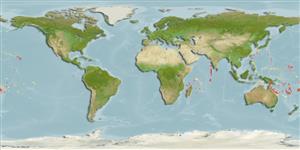Environment: milieu / climate zone / depth range / distribution range
Ecologia
marino associati a barriera corallina; distribuzione batimetrica 1 - 5 m (Ref. 58302). Tropical
Indo-Pacific: known only from Assumption Island in the Indian Ocean, Aldabra, Cosmodelo Group of the Seychelles, New Caledonia, Palau, Fiji, and Hawaii.
Size / Peso / Age
Maturity: Lm ? range ? - ? cm
Max length : 20.5 cm TL maschio/sesso non determinato; (Ref. 7490)
Short description
Morfologia | Morfometria
Brown color with the inside of the mouth white.
Benthic within rock crevices (Ref. 58302). A specimen was collected from 0-1.5 m depth (Ref. 7490).
Life cycle and mating behavior
Maturità | Riproduzione | Deposizione | Uova | Fecundity | Larve
Randall, J.E., J.L. Earle, T. Hayes, C. Pittman, M. Severns and R.L.F. Smith, 1993. Eleven new records and validations of shore fishes from the Hawaiian Islands. Pac. Sci. 47(3):222-239. (Ref. 7490)
IUCN Red List Status (Ref. 130435)
Threat to humans
Harmless
Human uses
Informazioni ulteriori
Nomi ComuniSinonimiMetabolismoPredatoriEcotossicologiaRiproduzioneMaturitàDeposizioneSpawning aggregationFecundityUovaEgg development
Age/SizeAccrescimentoLength-weightLength-lengthLength-frequenciesMorfometriaMorfologiaLarveDinamica popolazioni larvaliReclutamentoAbbondanzaBRUVS
BibliografiaAcquacolturaProfilo di acquacolturaVarietàGeneticaElectrophoresesEreditarietàMalattieElaborazioneNutrientsMass conversion
CollaboratoriImmaginiStamps, Coins Misc.SuoniCiguateraVelocitàModalità di nuotoArea branchialeOtolithsCervelliVista
Strumenti
Special reports
Download XML
Fonti Internet
Estimates based on models
Preferred temperature (Ref.
123201): 25.1 - 29.4, mean 27.9 °C (based on 1084 cells).
Phylogenetic diversity index (Ref.
82804): PD
50 = 1.0000 [Uniqueness, from 0.5 = low to 2.0 = high].
Bayesian length-weight: a=0.00102 (0.00046 - 0.00225), b=3.06 (2.88 - 3.24), in cm total length, based on all LWR estimates for this body shape (Ref.
93245).
Trophic level (Ref.
69278): 3.8 ±0.6 se; based on size and trophs of closest relatives
Fishing Vulnerability (Ref.
59153): Low vulnerability (11 of 100).
